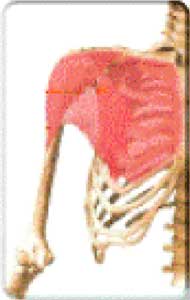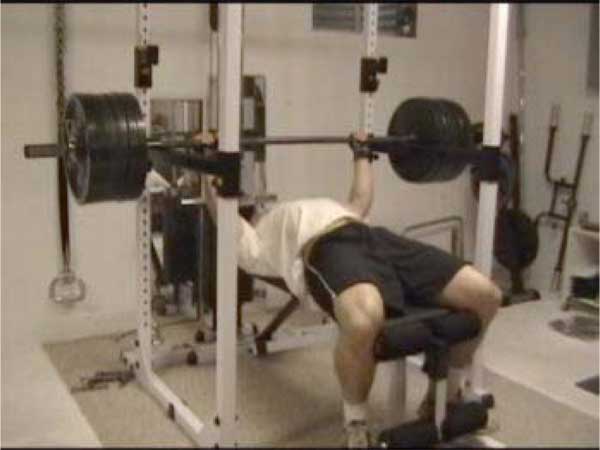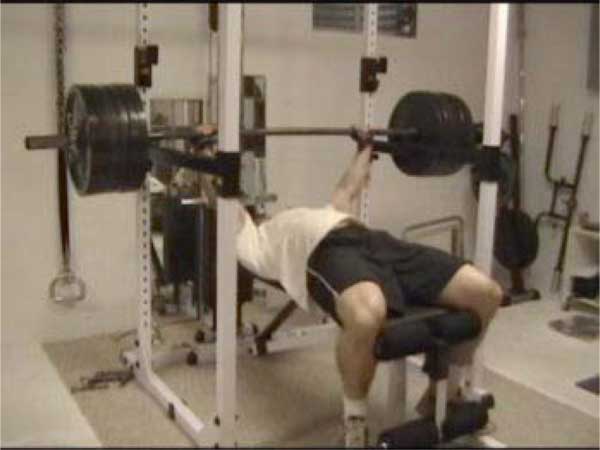

The partial bench press is a powerful technique that can be used to dramatically build your connective tissue strength and quickly increase your bench press weight.
By placing your muscles and connective tissue under much greater tension than during a full rep, you accustom your body to lifting far heavier weights.
The partial bench press is one of the most effective methods you can use for rapidly building your bench press poundages. The reason it is so effective is that it allows you to use much more weight than you normally would be able to use in the standard bench press.
The practical upshot of this is that you will strengthen your connective tissue (tendons and ligaments). Weak connective tissue is often the cause of strength plateaus. By building up your connective tissue, you are able to take your muscles further than they would otherwise normally be able to go.
The partial bench press can be done anywhere in the range of motion of the bench press to build specific strength in that range of motion. There are two ranges that I’ve found to be the most beneficial: top range and bottom range.
The top range of the bench press is the real powerhouse range. When you do flat bench presses in the top range, use extremely heavy weights (it is possible to work up to well over 200% of your maximum bench press weight - I’ve personally used over 700 pounds for reps at a bodyweight of around 200 pounds).
Lie down on the bench and get ready to push some heavy iron!


When doing the partial bench press starting from the bottom, set the safety pins to the lowest possible spot you can set them, where the bar is just off your chest. Measure this point with your rib cage expanded. This makes a few inches difference and is the position you should be in at the start of the push.
Doing the partial bench press from the bottom will help you to build great explosive power out of the bottom. After all, if you can’t lift the weight back out of the bottom, you’re not doing a complete rep.
It accomplishes this effect by completely removing all elastic tension in the muscles. In a normal rep, as you lower the bar down, you develop what’s known as elastic force (similar to when you stretch a rubber band). This assistive, elastic force contributes to the push back up to the top.
By taking this assisting force away, you force the muscle to be responsible for ALL the resistance, thereby increase the strength of the muscle at that very bottom point. Therefore, when you’re stronger at that point and you add back in the elastic force, you’ll be a whole lot stronger out of the bottom of the rep.
How to incorporate this exercise into your workouts:
Top-range partials are best done as the sole exercise of a chest workout.
The bottom-range partial can be used in conjunction with other chest exercises, especially those that work the contracted position of the muscle, i.e. cross-overs or pec deck.
1. Using too much or not enough weight
How much weight you use will depend on what part of the range of motion you are working. If you are working the very top range of motion, you should be using well over your maximum weight (you can work up to well over 200% of your 1 RM). If you are working the bottom range, you should be using about 75% of your maximum weight. Using too much or too little will not give as good results.
2. Not tightening up and preparing the body
In order to use maximum weight on the partial bench press, you must tighten up everything: arms, shoulders, abs, back, legs, grip, everything! When subjecting your body to this much load, stability is essential.
1. Getting the proper rack setting
The proper rack setting for partials can be difficult to find if the rack you are working with has holes that are relatively far apart. This does not leave you as many options for setting up but there are ways around it.
To adjust height on this type of rack, set the pins in the holes that are slightly higher than what you are looking for. Now slide 10 pound plates underneath the feet of the bench. This will raise the bench up to meet the pins. If it’s not high enough, try 25 pound plates.
2. Push yourself through the ground
When doing extremely heavy top range partials (or any bench press, really), imagine as though you are trying to push yourself down through the ground rather than trying to push the weight up. This will help to increase your pushing power.
3. High rep sets
An extremely useful technique in partial bench press is the high rep set. It not only allows you to use a lot more weight, it allows you to do it for a lot more reps. This combination of forcing a lot of blood into the area and working with heavy weights can really help strengthen your connective tissue. Connective tissue has a notoriously poor blood supply and anything you can do (i.e. high reps) to improve it is helpful.
A good way to include high rep sets is to do your really heavy sets first, strip off some of the weight, then finish with a weight that allows you to get 30 to 50 reps or so.